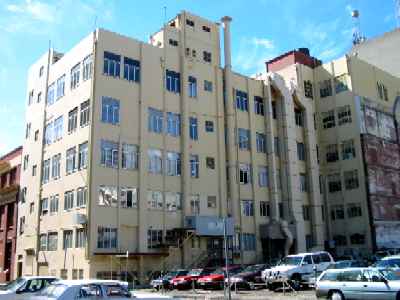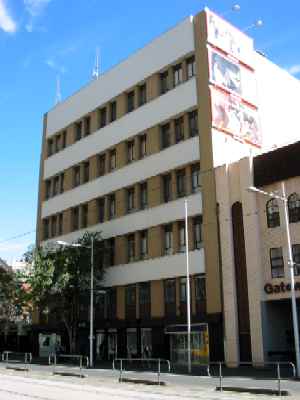On the eve of Anzac Day 1925, the city of Melbourne was preparing for a weekend of solemn remembrance still fresh was the memory of the Great War. It also happened to be payday for the six workers employed by George Arthur Marshall (1877-1925) of 106 Gore Street, Fitzroy one of ten children of William Marshall (d 1912) and Jane née Whitburne (d 1906). Marshall’s firm was subcontracted by “Cockram and Cooper” of Little Collins Street for lime washing and bagging on the construction of a five storied reinforced concrete building at 449 Swanston Street, Melbourne being built for the “British Australasian Tobacco Company Pty Ltd”; work had been progressing for the last six months and was due for completion at the end of July.

Around 4:20pm Marshall arrived with fresh supplies of lime for his men as well as their wages. William Oman of Oakleigh Crescent, Ormond was one of Marshall’s workers. While the others collected the lime, Oman was working near the lift well on the fourth floor facing à Beckett Street. Applying the first coat, only for it to go on yellow instead of white was yet another indication to Oman that the job was unlike any other he had experienced. Likewise fellow worker Reginald Forest Shaw of Little Cardigan Street, Carlton. That day he commenced lime washing the pillars on the fourth floor after the wooden formes used to hold the concrete in place were stripped. One of the pillars near the stairway was found to be vertically cracked on two sides requiring it to be bagged for a second time. Shaw would later describe the concrete on the fourth floor as “rotten” and noticed a “great difference” between the concrete on the first and second floors compared to the fourth. Even though they were impeded by the quality of the concrete that required a large amount of bagging to fill the cracks, the whitewashers had made good enough progress that only one more coat was required before moving to the next floor.
It was just before 4:35pm when Marshall began paying his men until Oman was next in line followed by John Reece of Rupert Street, Collingwood; in all there were between 18 and 20 workers on the fourth floor at the time. What happened next was so sudden, so devastating and incomprehensible that it caught all by surprise. Fate alone would be the arbiter of the outcome; the next few seconds would feel like hours. Percy Cole, builders’ labourer of Valentine Street, Thornbury working on the fifth floor above near the Swanston Street end heard a crack and saw the gantry move over and go back with a swing, the centre of the building collapse like a basin and the rear section fall outwards onto Stewart Street. On the fourth floor, Oman, standing inches away from Marshall collecting his pay was narrowly missed by a falling steel girder which unluckily struck his boss killing him instantly. He was buried to his armpits and struggled desperately for life and freedom shifting two concrete blocks; when freed he was still clutching a pound note. John Reece heard “a roar like thunder” and looking upwards saw the blue sky that had been the roof seconds before and made a scramble for the safety of the scaffolding on Swanston Street just as a second roar sounded and the whole fifth floor collapsed as did a portion of the fourth level as hundreds of tonnes of concrete fell under the tremendous weight.
The effect of the men rushing down the scaffolding and a massive cloud of white dust gave the appearance of a fire and the brigade was summonsed. Luckily most of the carpenters working on the crumbled fourth floor were at the Swanston Street end thus escaping the full brunt of the collapse. In no time a rescue party of some 40 eager volunteers of “tobacco workers, comrades and members of the public” led by John Murray immediately got to work in search of survivors in spite of the imminent danger of a further collapse and “they worked as only Australian workmen can when life is at stake”. Rushing up the staircase at speed to the waste of shattered concrete that was the fourth floor, the rescuers came across Marshall’s body and within minutes had extricated his brother-in-law, Edward Faulkiner of Oakleigh Crescent, Auburn who had been pinned down by fallen timbers sustaining severe spinal injuries. Reg Shaw had a truly miraculous escape. Completely buried but for one hand, with the aid of his rescuers he endeavoured frantically to clear his face and was near collapse just as he was saved; when extricated, his only worry was his wife and two kiddies (“they’ll send someone to tell the wife won’t they mister?”) and after being reassured “settled down with true Australian stoicism to face what the future had in store”.
Another who had a lucky escape was A McBride of Messrs “Currie & Richards” of Stewart Street who was standing outside the factory about to light his pipe when he heard a noise like heavy hail and on looking up was showered with dust falling down. He stood back narrowly avoiding a terrific crash of huge pieces of scaffolding and concrete where he once stood moments before. The rescue party worked frantically searching for survivors recovering the bodies of Victor Leslie Ingham (1887-1925, Warringal Cemetery) and Edgar Thomas Lydiard (c1903-25) just after 6:00pm eventually suspending work when the fourth victim, Hugh Percival Archibald (1891-1925, Coburg Cemetery) of Yarra Street, South Melbourne was found at 9:40pm. Amongst the three lucky survivors was Marshall’s son George John Arthur (1905-25) who later succumbed to his injuries on 7 December that year and lies interred with his father.

It was inevitable that a searching coronial inquiry would be held into the causes of what was the first case of the collapse of a reinforced concrete building with the loss of life. Just what happened on that fateful day and who was to blame? Why did the building regulations fail to prevent the tragedy and was there adequate supervision by the building contractors? Not surprisingly, the nine day inquest before Coroner D Berriman PM was the second longest held in 20 years; over 50 witnesses, experts and officials were called involving some of the major legal firms of the day, including (Sir) Robert Gordon Menzies (Melbourne General Cemetery) of “Fink, Best and Miller” representing the “British Australasian Tobacco Company”. Opening on 16 June, the inquest was to hear a litany of contributing factors, amongst these were the weakening of the concrete by 40% due to excess water; critical design flaws and inadequate plans; and a lack of supervision and inspection from the city council building inspectors down to the clerk of works. Clarence Sexton, lecturer in civil engineering at Melbourne University concluded the causes of failure was due to:
- the omission of the main wall beam at the fourth floor level on the western side of the northern light area;
- the omission of steel from certain girders;
- weakness of concrete due to excess of water;
- lack of supervision adequate to ensure that all bars and sizes of members were effectively directed and passed as correct before concrete was poured; and
- the use of higher working stresses in the concrete than were justified in view of the methods of design and construction which were permitted in city buildings.
The coroner was to find the contractor Robert William Astley Cooper, clerk of works George Albert Royal and the architect Francis James Davies all guilty of criminal negligence. However after studying the evidence, the Crown Prosecutor, Hugh Macindoe (q.v.) found that there was no case to go to a jury and filed a nolle prosequi (not to proceed), but agreed with Berriman’s finding that the three “were jointly and severally” negligent in the supervision of the work.
A veteran of the Great War with the 22nd Battalion AIF (No 5125, enlisted 23 May 1916 returned 20 Jan 1919), in 1900 Marshall married Annie née Davies (Davis) and they had four children: Annie (1900-05), George (1905-25), Rosalind Wilkinson née Marshall (1908-79) and May (b 1913). Just when Marshall should have been remembering his mates killed in the war he was laid to rest at the Brighton General Cemetery on Monday 27 April (CofE*ZF*780).
Source:
The Age 25, 27 April 1925, 18, 19, 20, 23, 24, 25, 26, 27, 30 June 1925, 14, 15, 18 September 1925.
The Argus 25, 27 April 1925, 8 December 1925, 1 May 1926.
The Herald 25 April 1925 & 29 June 1925.
AWM “Biographical Cards for the Official History 1914-18”, AWM140.
